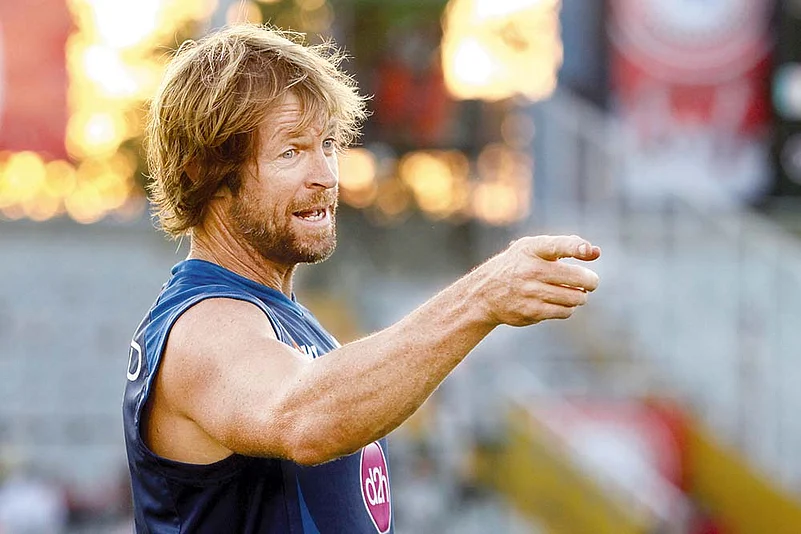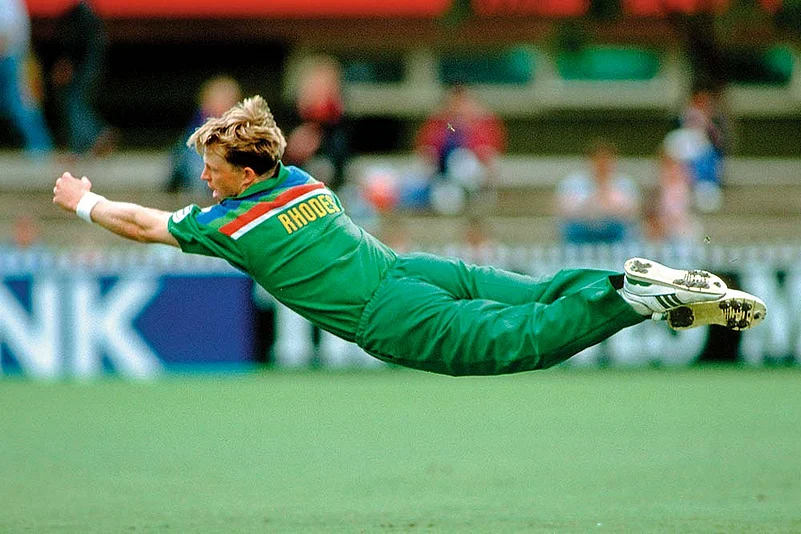If there was a brand equity attached to each of the three departments of cricket, Jonty Rhodes would unquestionably walk away with the fielding honours. Ever since he flew like a bird from backward point to spectacularly run out Pakistan’s Inzamam-ul-Haq in a 1992 World Cup match in Brisbane, Rhodes continues to remain the barometer for fielding standards. The 51-year-old is now the fielding coach of Kings XI Punjab. A quintessential journeyman, Rhodes relationship with India is unique. Snowboarding in Kashmir, house-boating in Kerala, surfing in the Bay of Bengal or enchanted by the goodness of Ayurveda and yoga, Rhodes middle name could well have been ‘India.’ Indeed, he named his daughter thus. In a freewheeling interview from Dubai with Soumitra Bose, Rhodes spoke about cricket, wellness, evils of society and his upcoming Swedish adventure. Excerpts.
Outlook: Jonty, you are such a multi-faceted person—cricketer, business banker, tourism ambassador, wellness spokesman, surfing freak, motorbiker.…
Jonty Rhodes: I suppose it’s about living life to the maximum without taking any unnecessary risks. I have suffered a few broken fingers, a few aches but I do like to take up most opportunities presented to me. I am definitely more of a glass-half-full personality. At school, I played tennis, hockey, soccer, cricket and was an athlete. My tennis coach said that I would be a Jack of all trades and good at none. That pretty much sums me up.
Aren’t you being modest? You could have played hockey in two Olympic Games, but ended up an international cricketer. You were such a natural fielder at point.
My fielding was a combination of all the sports I played. As a centre-forward in hockey and as a soccer player, I would see what goalkeepers would do and as a fielder I saw myself as a goalkeeper. In tennis, there was the backhand and forehand to return serve. So there was the split jump position that allowed you to move laterally. As a hockey player, I was fit. I could run faster because I had the ball at the end of the stick, trying to get away from the opposition. That allowed me to field over the five metres in the cover region and backward point without having to run upright and then bend. Being a jack of all trades allowed my fielding to develop naturally.
You were born in Pietermaritzburg. Mahatma Gandhi’s fight against oppression, racism and colonialism started from there in June 1893. Do you see any change in society?
Gandhi’s message of non-violence has been lost. That there is a need to protest shows that what he was fighting or trying to change hasn’t been accomplished still. We see forms of bigotry or racism and South Africa too have had major race issues 26 years after democracy. We are still a young democracy but South Africa still hasn’t found its feet. For a long time under our first president, Nelson Mandela, South Africa was termed the Rainbow Nation. Sadly, that has been lost to an extent.

South Africa’s cricket is in the doldrums. Is that a reflection of the prevailing ecosystem?
Our cricket is part of the bigger system. The COVID-19 pandemic and lockdowns have shown that though there is political freedom in S. Africa, economic inequalities still exist from the apartheid regime. You wonder how it has been allowed to go this far. We have corruption issues in government and in corporates that deal with government. We still have massive inequality. But there is racism not only in countries like S. Africa, but also in the US, Europe and around the world. A lot of this stems from bigotry and not understanding others’ situation or not wanting to understand their cultures.
Talking of cultures, you have been a big fan of India.
Every time I am in India, I make sure that I get on an Enfield and ride throughout the country, because you can’t experience culture if you are flying 36,000 feet above the ground. Sadly, we have put a lot of boundaries within ourselves.
As we speak, several women have been raped in India. Does your love for India get impacted?
I have not seen one-tenth of India and it will not be right to point a finger, but yes, in South Africa, we have gender-based issues and violence against women and children have hurt us more than the pandemic. I have been following what is happening in India; in a patriarchal society there are these issues. We had a baby girl in India (in 2015) and named her ‘India’. Daughters are so important to a country’s prosperity and there has been an issue around the world for the girl child. It is a sad situation not unique to India.

Nicholas Pooran’s acrobatic, boundary-saving act in the IPL
Why did you name your daughter, India?
My wife Melanie is a qualified yoga teacher and architect and she follows Vedanta philosophy. So, having a baby in India was a real spiritual journey for her. Melanie’s reason for naming her ‘India’ was slightly different from mine. For me it was the great experience of diversity…every time I rode out on a bike from Nariman Point to Wankhede stadium, something different happened. That’s incredible.
Your son Nathan was born in 2017. You never thought of an ‘Indian’ name?
See, we didn’t want Indians to think that naming our daughter ‘India’ was a marketing ploy because we got a very positive response. We didn’t want people to say ‘Jonty has a son now and he has been named him, Bharat!’ Like following up with Marketing 2.0.
You are now associated with a wellness company in India….
I became the director of We R Wellness after five years of discussion. In India people see Bollywood actors and the men especially want to have ripped biceps and six-pack abs. There is a belief that this is what fitness is all about. From an athlete’s point of view, you can’t get everything from your diet. Supplementation is required. Natural remedy for endurance and recovery will be the way forward because there is no risk of any contamination.

The gravity-defying grab that made Jonty immortal.
Why did you choose to become the coach of Sweden?
I took a break from IPL in the last two years. I have been doing developmental and grassroots coaching. My parents were teachers and I love being a teacher. I have spent time with underprivileged kids in South Africa, have also been to Nepal twice, Malawi, Zimbabwe and tried to focus on areas where there is a real need to not just to train young players but to coach the coaches. I have been following European and North American cricket; these are growing markets. I have looked at how South Africa has managed the pandemic. South Africa had two quarters of negative growth; before the pandemic struck, we were in financial hot water and unemployment had reached over 35 per cent. My wife is an architect, a big fan of Swedish design and their schooling system. Sweden is a socialist country, their universal education is admired worldwide. From a cricketing point of view, Sweden doesn’t have much expertise but the game has grown over 300 per cent in the last three years. I have no aspiration to coach a Test-level country, not even as a head coach of an IPL team. We will relocate to Sweden as a family and it will be challenging to face the long dark hours there because we don’t have much of a winter in SA. We arrive in the middle of December.
How has Twenty20 cricket changed fielding? What will you tell Swedish players? Field like Jonty or field like Nicholas Pooran?
Fielding at the boundary has become a big part of the game. It was not there before powerplays were introduced. In Twenty20, batsmen have to take the aerial route. Defending the boundary, where you are catching or bringing the ball back and passing it on is something we practice. Pooran didn’t complete the catch but the four runs he saved can be the difference between winning and losing.
Secondly, you can’t hide even three players in a T20 game. You need at least seven 360 degree players who are great athletes.
How was fielding in the Nineties?
When we returned to cricket, there was no action outside the circle. The bats were different, there were no powerplays and there was no need to go anywhere other than backward point or mid-wicket for the off-spinner or short cover for the left arm spinner. South Africa had a good pace bowling attack with Donald, McMillan, Pollock and Klusener and the top of off-stump or fourth stump were where they were targeting. So backward point and gully was where all the action was. These days, the first six overs you are in the circle and then you want to be in the action hotspots—long on, long off, cowshot corner and that’s where you will find your better fielders. In fact, my dive into the stumps that captivated everyone’s imagination in 1992 is completely out of fashion now!
















